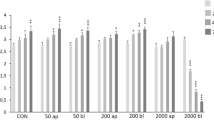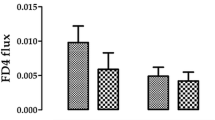Abstract
Deoxynivalenol (DON) has critical health effects if the contaminated grains consumed by humans or animals. DON can have negative effects on the active transport of glucose and amino acids in the small intestine of chickens. As the underlying mechanisms are not fully elucidated, the present study was performed to delineate more precisely the effects of cycloheximide (protein synthesis inhibitor, CHX) and DON on the intestinal absorption of nutrients. This was to confirm whether DON effects on nutrient absorption are due to an inhibition of protein synthesis. Changes in ion transport and barrier function were assessed by short-circuit current (Isc) and transepithelial ion conductance (Gt) in Ussing chambers. Addition of d-glucose or l-glutamine to the luminal side of the isolated mucosa of the jejunum increased (P < 0.001) the Isc compared with basal conditions in the control tissues. However, the Isc was not increased by the glucose or glutamine addition after pre-incubation of tissues with DON or CHX. Furthermore, both DON and CHX reduced Gt, indicating that the intestinal barrier is compromised and consequently induced a greater impairment of the barrier function. The remarkable similarity between the activity of CHX and DON on nutrient uptake is consistent with their common ability to inhibit protein synthesis. It can be concluded that the decreases in transport activity by CHX was evident in this study using the chicken as experimental model. Similarly, DON has negative effects on the active transport of some nutrients, and these can be explained by its influence on protein synthesis.


Similar content being viewed by others
References
Awad WA, Böhm J, Razzazi-Fazeli E, Hulan HW, Zentek J (2004) Effects of deoxynivalenol on general performance and electrophysiological properties of intestinal mucosa of broiler chickens. Poult Sci 83:1964–1972
Awad WA, Böhm J, Razzazi-Fazeli E, Zentek J (2005a) In vitro effects of deoxynivalenol on electrical properties of the intestinal mucosa of laying hens. Poult Sci 84:921–927
Awad WA, Rehman H, Böhm J, Razzazi-Fazeli E, Zentek J (2005b) Effects of luminal deoxynivalenol and l-proline on electrophysiological parameters in the jejunums of laying hens. Poult Sci 84:928–932
Awad WA, Böhm J, Razzazi-Fazeli E, Zentek J (2006a) Effects of feeding deoxynivalenol contaminated wheat on growth performance, organ weights and histological parameters of the intestine of broiler chickens. J Anim Physiol Anim Nutr 90:32–37
Awad WA, Razzazi-Fazeli E, Böhm J, Ghareeb K, Zentek J (2006b) Effect of addition of a probiotic microorganism to broiler diets contaminated with deoxynivalenol on performance and histological alterations of intestinal villi of broiler chickens. Poult Sci 85:974–979
Awad WA, Aschenbach JR, Setyabudi F, Razzazi-Fazeli E, Böhm J, Zentek J (2007a) In vitro effects of deoxynivalenol on small intestinal d-glucose uptake and absorption of deoxynivalenol across the isolated jejunal epithelium of laying hens. Poult Sci 86:15–20
Awad WA, Razzazi-Fazeli E, Böhm J, Zentek J (2007b) Influence of deoxynivalenol on the d-glucose transport across the isolated epithelium of different intestinal segments of laying hens. J Anim Physiol Anim Nutr 91:175–180
Awad WA, Ghareeb K, Böhm J, Razzazi E, Hellweg P, Zentek J (2008a) The impact of the Fusarium toxin deoxynivalenol (DON) on poultry. Int J Poult Sci 7:827–842
Awad WA, Razzazi-Fazeli E, Böhm J, Zentek J (2008b) Effects of B-trichothecenes on luminal glucose transport across the isolated jejunal epithelium of broiler chickens. J Anim Physiol Anim Nutr 92:225–230
Awad WA, Hess M, Twarużek M, Grajewski J, Kosicki R, Böhm J, Zentek J (2011a) The impact of the Fusarium mycotoxin deoxynivalenol on the health and performance of broiler chickens. Int J Mol Sci 12:7996–8012
Awad WA, Vahjen W, Aschenbach JR, Zentek J (2011b) A diet naturally contaminated with the Fusarium mycotoxin deoxynivalenol down regulates gene expression of glucose transporters in the intestine of broiler chickens. Livestock Sci 140:72–79
Awad WA, Aschenbach JR, Zentek J (2012) Cytotoxicity and metabolic stress induced by deoxynivalenol in the porcine intestinal IPEC-J2 cell line. J Anim Physiol Anim Nutr 96:709–716
Awad WA, Molnar A, Aschenbach JR, Ghareeb K, Khayal B, Hess C, Liebhart D, Dublecz K, Hess M (2014) Campylobacter infection in chickens modulates the intestinal epithelial barrier function. Innate Imm. doi:10.1177/1753425914521648
Csaky TZ, Fischer E (1981) Intestinal sugar transport in experimental diabetes. Diabetes 30:568–574
De Walle JV, Sergent T, Piront N, Toussaint O, Schneider YJ, Larondelle Y (2010) Deoxynivalenol affects in vitro intestinal epithelial cell barrier integrity through inhibition of protein synthesis. Toxicol Appl Pharmacol 245:291–298
Diesing AK, Nossol C, Danicke S, Walk N, Post A, Kahlert S, Rothkötter HJ, Kluess J (2011) Vulnerability of polarised intestinal porcine epithelial cells to mycotoxin deoxynivalenol depends on the route of application. PLoS ONE 6:e17472
Fleming SE, Fitch MD, DeVries S, Liu ML, Kight C (1991) Nutrient utilization by cells isolated from rat jejunum, cecum and colon. J Nutr 121:869–878
Fleming SE, Zambell KL, Fitch MD (1997) Glucose and glutamine provide similar proportions of energy to mucosal cells of rat small intestine. Am J Physiol 273:G968–G978
Frizzell RA, Nellans HN, Acheson LS, Schultz SG (1973) Effects of cycloheximide on influx across the brush border of rabbit small intestine. Biochim Biophys Acta 291:302–307
Gesellschaft für Ernährungsphysiologie (GfE) (1999) Empfehlungen zur Energie- und Nährstoffversorgung von Legehennen u. Masthühnern (Broiler). DLG Verlag, Frankfurt
Ghareeb K, Awad WA, Soodoi C, Sasgary S, Strasser A, Böhm J (2013) Effects of feed contaminant deoxynivalenol on plasma cytokines and mRNA expression of immune genes in the intestine of broiler chickens. PLoS ONE 8:e71492
Kouadio JH, Dano SD, Moukha S, Mobio TA, Creppy EE (2007) Effects of combinations of Fusarium mycotoxins on the inhibition of macromolecular synthesis, malondialdehyde levels, DNA methylation and fragmentation, and viability in Caco-2 cells. Toxicon 49:306–317
Maresca M, Mahfoud R, Garmy N, Fantini J (2002) The mycotoxin deoxynivalenol affects nutrient absorption in human intestinal epithelial cells. J Nutr 132:2723–2731
Pestka JJ (2008) Mechanisms of deoxynivalenol-induced gene expression and apoptosis. Food Addit Contam 25(9):1128–1140
Pinton P, Nougayrede JP, Del Rio JC, Moreno C, Marin DE, Ferrier L, Bracarense AP, Kolf-Clauw M, Oswald IP (2009) The food contaminant deoxynivalenol, decreases intestinal barrier permeability and reduces claudin expression. Toxicol Appl Pharmacol 237:41–48
Pinton P, Braicu C, Nougayrede JP, Laffitte J, Taranu I, Oswald IP (2010) Deoxynivalenol impairs porcine intestinal barrier function and decreases the protein expression of claudin-4 through a mitogen-activated protein kinase-dependent mechanism. J Nutr 140:1956–1962
Rhoads J, Keku O, Quinn J, Woosely J, Lecce J (1991) l-Glutamine stimulates jejunal sodium and chloride absorption in pig rotavirus enteritis. Gastroenterology 100:683–691
Tang D, Lahti JM, Grenet J, Kidd VJ (1999) Cycloheximide-induced T-cell death is mediated by a Fas-associated death domain-dependent mechanism. J Biol Chem 274:7245–7252
Yang GH, Jarvis BB, Chung YJ, Pestka JJ (2000) Apoptosis induction by the satratoxins and other trichothecene mycotoxins: relationship to ERK, p38 MARK, and SAP/JNK activation. Toxicol Appl Pharmacol 164(2):149–160
Conflict of interest
None of the authors have a conflict of interest.
Author information
Authors and Affiliations
Corresponding author
Rights and permissions
About this article
Cite this article
Awad, W.A., Zentek, J. The feed contaminant deoxynivalenol affects the intestinal barrier permeability through inhibition of protein synthesis. Arch Toxicol 89, 961–965 (2015). https://doi.org/10.1007/s00204-014-1284-9
Received:
Accepted:
Published:
Issue Date:
DOI: https://doi.org/10.1007/s00204-014-1284-9




